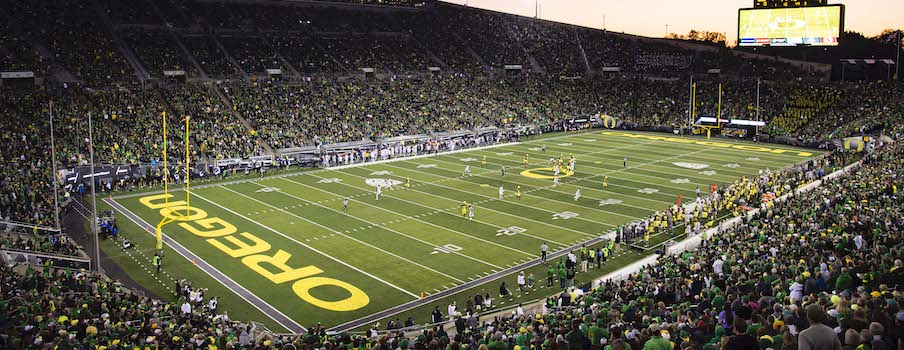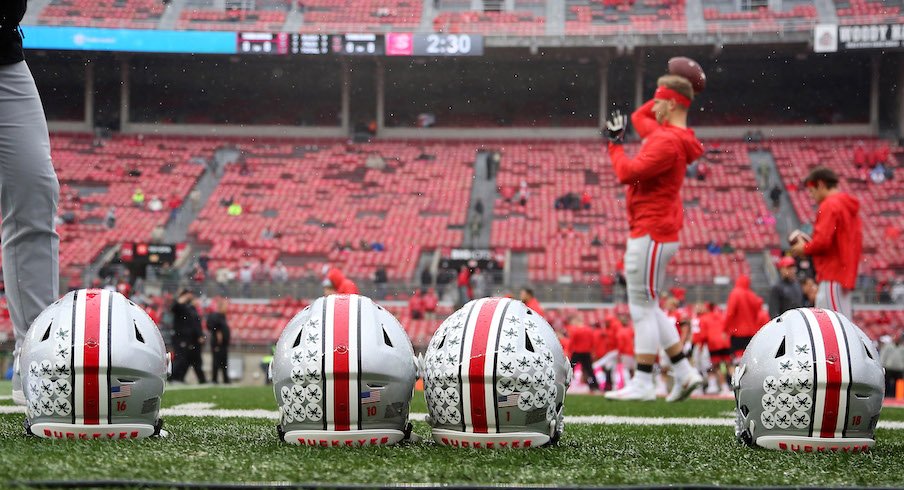Gene Smith would be happy to have Oregon come to Ohio Stadium instead of Ohio State travel to Eugene this year – but only if the Buckeyes can still host the Ducks next year, too.
“We’ll just play both of them here, two years in a row,” Smith joked when he was asked on Wednesday about the possibility of flipping the games between Ohio State and Oregon’s football teams, scheduled to be played at the Horseshoe this September and at Autzen Stadium next September.
In all seriousness, though, Smith doesn’t anticipate a swap in the home-and-home series that would bring Oregon to Columbus in 2020 and postpone Ohio State’s trip to the Pacific Northwest until 2021. While Ohio State’s athletic director spoke with Oregon athletic director Rob Mullens a couple days after the Oregon Health Authority called for all large gatherings in the state to “be canceled or significantly modified” through September – fueling suggestions that the games between the Buckeyes and Ducks should be flipped – both athletic directors say that option has not been specifically discussed, and Smith doesn’t believe it would be in Ohio State’s best interest.
“We did not talk about that scenario,” Smith said. “It’s the first time I’ve thought about it, so I’m not so sure I have a strong opinion on it, because we would be probably giving up a game next year in ‘21, which would make it harder for us. So I’m not so sure I would do that.”
While it’s uncertain at this point whether Oregon will be able to host that game – and if it does, whether it will be able to have any fans in attendance – there are 50,000 to 80,000 reasons for Ohio State not to agree to a switch. The 2021 game between the Buckeyes and Ducks is set to be Ohio State’s home opener for that season, and one that will surely pack the Ohio Stadium stands as long as the COVID-19 pandemic is under control by then. This year, however, Ohio Stadium could be limited to a maximum of 20,000 to 50,000 fans – if fans are able to attend games at all – significantly reducing the profitability of adding a marquee non-conference game to the home schedule.
Another reason not to flip the games: Ohio State meticulously builds its football schedules so that it has seven home games each year. If the Buckeyes were to instead travel to Oregon next year, they’d instead have only six home games in 2021 – and in a year where they’ll likely need to make up for any financial losses they incur this year, they certainly won’t want that.
Given that, this year’s game between the Buckeyes and Ducks likely remains contingent on whether Oregon is able to host that game on Sept. 12 and whether Ohio State is comfortable with making that trip to the West Coast. Mullens said last week he is still hopeful that Oregon will be able to host all of its September non-conference games, also including contests against North Dakota State and Hawaii, and like Smith and Ohio State, Oregon is looking at all options including potentially playing games in front of empty stands or reduced crowds.
"Our goal is to play as many games as possible. We'd love to play all 12 because we have a very exciting schedule, but understand that health and safety would be the priority," Mullens said last Friday, according to Duck Territory’s Matt Prehm.
Smith is likewise hopeful that Ohio State will be able to play all 12 of its regular-season games, also including September non-conference home games against Bowling Green and Buffalo, though he said Wednesday the possibility of playing only conference games this year could be on the table.
“It'd be easier for us to make sure that we have the safest environment for our student-athletes if we just competed against Big Ten schools,” Smith said. “We're familiar with locker rooms. We're familiar with the hotels we're going to. We have familiarity with the travel operations we have to employ. So those are easier. But can we come up with a national solution where we have standards and protocols where everybody is in operation and implements wherever we go? I think it can be done. But it is murky and messy right now because of just everyone trying to get coordinated.”
The Buckeyes wouldn’t have to worry about traveling for its games against Bowling Green and Buffalo, so as long as Ohio State is confident it will be prepared to safely host football games in September, those games could hinge on whether the two MAC schools are prepared to play football games and go on the road in September. Both of them have more than a million reasons to go through with those trips to Columbus, as Ohio State is set to pay Bowling Green $1.2 million and Buffalo $1.8 million for those games, while each school would owe Ohio State $1 million in damages if it backs out of the game.
That said, there are clauses within the contracts for each of those non-conference games – including the Oregon game, for which Oregon is set to pay Ohio State $300,000 this year, with Ohio State set to reciprocate next year – that could potentially be invoked if COVID-19 forces any of those games not to happen.
The “force majeure” clause in the Oregon game contract stipulates that “neither party shall be responsible to the other for any loss or damage” if the game needs to be canceled due to reasons that include “any order of government, military or public authority.” That clause does state that “except as agreed by the parties, no such cancellation shall affect the parties’ obligations regarding subsequent games covered by this Agreement,” so if that clause was invoked for this year’s game, the Ducks would still be contractually obligated to come to Columbus in 2021.

Section 13 of the Bowling Green and Buffalo contracts include similar language, stipulating that “neither party will be responsible to the other for any loss or damage” in a situation where “it becomes impossible to play the game” for reasons that include “other unforeseen catastrophes or disasters beyond the control of either party.”
Whether those clauses would be applicable to the coronavirus pandemic is uncertain as of now, but Smith said he would defer to Ohio State’s legal team if it becomes necessary to cancel any of those games.
“I’m hopeful that we can play 12 games, because I certainly having come from Eastern Michigan (where he was the athletic director from 1986-93) and knowing how that world works, I want to play those games not just for us but for those schools,” Smith said. “But yes, we’ll have to look at that clause in the contract if we get to that point. I don’t know. I have to defer to legal in its viability of standing up.”
Should Ohio State be ready to play at the start of September but unable to travel to Oregon or any of those other schools be unable to play, the Buckeyes could seek out replacement opponents; theoretically, there will be other schools also in the last-minute market to reschedule September non-conference games, given that varying policies between states and universities could lead to some college football teams returning to the field before others this season.
At this stage, Ohio State is still preparing to play all of its games as originally scheduled, and Smith said he isn’t at a point of being ready to make any decisions about potential changes yet. By early July, though, he believes it will be necessary for Ohio State to make final decisions about what its football schedule will look like in 2020.
“I think we need to not rush this, and I know everyone is anxious to do that, but we need to have the opportunity for our medical experts to continue to collect data, see how our human behavior responds in the reopening environment across the country,” Smith said. “We need to take into consideration not just Ohio but all the other states. So we need to allow time, which in my view may take all of June. Different schools will make different decisions on reopening at different times, so we need to allow that to cascade over time.
“But I think somewhere in early July, we need to have clarity on what we're doing because, one, we need to think about the student-athletes and their families and what their schedule looks like in their world. Then, of course, we need to consider the operational time that needs to be put in place to manage whatever we ultimately do.”
If Ohio State’s current schedule remains intact, the Buckeyes’ season opener against Bowling Green will be played on Sept. 5, followed by their trip to Oregon on Sept. 12 and the Buffalo game on Sept. 19. Ohio State is then scheduled to begin conference play on Sept. 26 with a home game against Rutgers, with four more Big Ten games in both October and November, concluding with the annual regular-season finale against Michigan, which this year is set to be played in the Shoe.


